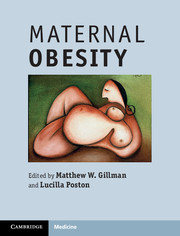Book contents
- Frontmatter
- Contents
- Contributors
- Preface
- Section 1 Trends and determinants of obesity in women of reproductive age
- Section 2 Pregnancy outcome
- Section 3 Long-term consequences
- Section 4 Interventions
- Section 5 Management and policy
- 18 Clinical management of obesity in pregnancy
- 19 Public health policies relating to obesity in childbearing women
- Index
- Plate Section
- References
19 - Public health policies relating to obesity in childbearing women
from Section 5 - Management and policy
Published online by Cambridge University Press: 05 August 2012
- Frontmatter
- Contents
- Contributors
- Preface
- Section 1 Trends and determinants of obesity in women of reproductive age
- Section 2 Pregnancy outcome
- Section 3 Long-term consequences
- Section 4 Interventions
- Section 5 Management and policy
- 18 Clinical management of obesity in pregnancy
- 19 Public health policies relating to obesity in childbearing women
- Index
- Plate Section
- References
Summary
The development of obesity is more complex in women than in men because, in addition to the usual reasons for becoming obese, the vast majority of women become pregnant at some point in their life (85% by age 44yr) [1], and substantial weight gain is recommended for each pregnancy. Depending on a woman’s pre-pregnancy body mass index (BMI), the latest American guidelines [2] recommend that women be weighed during each routine prenatal care visit and gain as little as 5kg or as much as 18kg during pregnancy (Table 19.1). Unfortunately, the weight gained during pregnancy may be difficult to lose postpartum [3]. Women who are too heavy when they conceive have a high risk for complications of pregnancy and difficulties with labor and delivery (reviewed in [2,4]), so it is important for women to conceive at a normal BMI, gain weight appropriately while pregnant, and then return to their pre-pregnancy weight postpartum before becoming pregnant again [2].
Within the American context, national public health policies and programs related to helping women to conceive at a healthy weight, gain weight appropriately during pregnancy, and limit weight retention postpartum will be covered in this chapter. In addition, the specific challenges involved in developing guidelines for gestational weight gain (GWG) among the heaviest women will be considered.
The United States does not have an oi cial policy related to nutrition in general or the prevention of maternal obesity more specifically. Instead it has developed a variety of norms, standards, and targets that serve as the foundation for action by individuals, organizations, and local, state and federal agencies. Among other possibilities, they may be derived from the deliberations of expert committees, whose work is ot en commissioned by the federal government. For example, since 1970, three such committees have published guidelines for GWG [ 2,5,6]. This guidance not only informs the development of various federaland state-level policy instruments, as discussed below, but it can also be inl uential in changing the recommended practices or standards of care used by health care providers (e.g., the adoption of guidelines for GWG by the American Congress of Obstetricians and Gynecologists) as happened recently [7].
Keywords
- Type
- Chapter
- Information
- Maternal Obesity , pp. 237 - 244Publisher: Cambridge University PressPrint publication year: 2012
References
- 1
- Cited by



